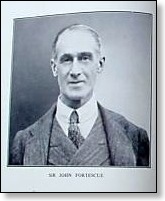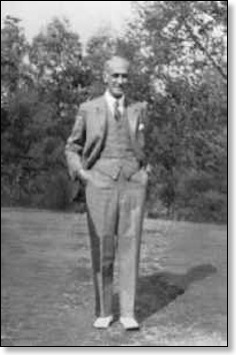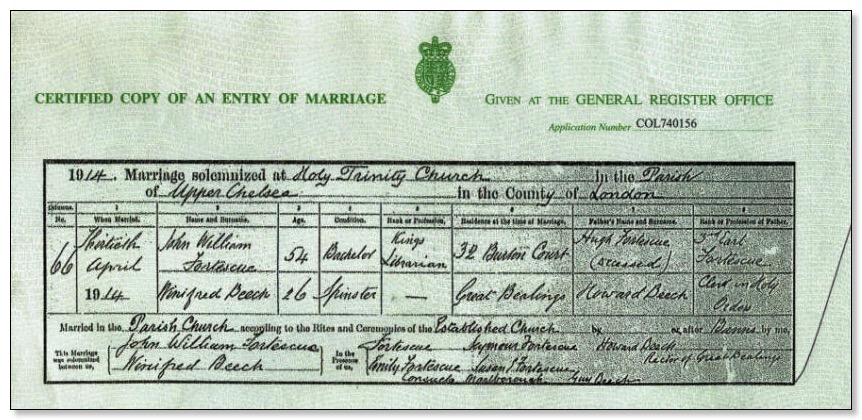All pictures and data from http://www.perfumefromprovence.com/Sirjohnfortescue.htm
. .

 ???
???  .
. 
THE HON. SIR JOHN W FORTESCUE
LL.D. (Edinburgh), D.Litt. (Oxford),
Hon. Fellow Trinity College (Cambridge),
K.C.V.O. (1926), C.V.O. (1917), M.V.O. (1907),
HISTORIAN OF THE BRITISH ARMY,
AUTHOR, LIBRARIAN & ARCHIVIST AT WINDSOR CASTLE,
EDITOR OF THE CORRESPONDENCE OF KING GEORGE III.
FORTESCUE, SIR JOHN WILLIAM (1859-1938), military historian, was born in Madeira 28 December 1859, the fifth son of Hugh Fortescue, third Earl Fortescue, by his wife, Georgiana Augusta Charlotte Caroline, eldest daughter of Colonel George Lionel Dawson-Damer, third son of John Dawson-Damer, first Earl of Portarlington. He was descended from Chief Justice Sir John Fortescue [q.v.] Brought up in country surroundings at Castle Hill, near Barnstaple, he developed a great love of country life and pursuits with a countryman's eye for ground, which stood him in good stead in explaining the battlefields which he described. He was educated at Harrow under H. M. Butler [q.v.], to whose love of English literature he owed much. Short sight curtailed his athletic activities, besides debarring him from a military career; he therefore entered Trinity College, Cambridge, in 1878, intending to read for the bar, but, finding the law uncongenial, in 1880 he became private secretary to Sir William Robinson, governor of the Windward Islands; two years in the West Indies aroused his interest in their history and connection with the army.
After completing his degree at Cambridge Fortescue spent four years in New Zealand (1886-1890) as private secretary to the governor, Sir Williaim Jervois [q.v.], during which he began writing and had several articles accepted by Macmillan's Magazine. This led to his contributing a volume on Dundonald to Macmillan's 'English Men of Action' series (1896), which was preceded in 1895 by a history of his elder brother Lionel's regiment, the 17th Lancers. Messrs. Macmillan then commissioned him to write a popular one volume history of the British army. Finding it impossible to do justice to his subject in so brief a compass he obtained the publishers' assent to a more ambitious venture in four volumes. The first two (1899), which reached 1713 and 1763, were at once recognized as a really authoritative contribution to the subject, but when a third (1903) and a fourth (1906) only reached 1792 and 1802 it became evident that the work must extend far beyond the limits contemplated. Finally thirteen volumes appeared, the last (continuing to 1870) in 1930. Few historians have ventured on so large a project, still less accomplished it single handed.
A work on such a scale, copiously provided with elaborate maps, could not be remunerative and Fortescue would not have been able to complete it had not King Edward VII in 1905 appointed him librarian at Windsor Castle. This post, which he held until 1926, although it involved the rearrangement and care not only of the books but of the pictures and other collections, enabled him to carry on his history, which owed much to the encouragement of the King and his successor. As King's librarian he accompanied the King and Queen to India in 1911 for the coronation durbar, of which he wrote the official account (1912).

SIR JOHN W FORTESCUE
The date of this photograph is not certain but is possibly the early 1930's.
It was used in the front of his last book 'The Last Post'.
Winifred managed to get this published in 1934 with the help
of Philip Guedalla*, following Sir John's death in 1933
|
He was appointed C.V.0. in 1917 and K.C.V.0. in 1926. He was elected an honorary fellow of Trinity College, Cambridge, in 1920, received honorary degrees from the universities of Oxford and Edinburgh, and was awarded the Chesney gold medal of the Royal United Service Institution. He delivered the Ford lectures (1911), published the same year as British Statesmen of the Great War, 1793-1814, and the Romanes lecture (1929) at Oxford, and the Lees-Knowles lectures at Cambridge (1914).
|
|
Fortescue published many works besides the History of the British Army. He edited six volumes of the Correspondence of King George the Third (1927-1928) and seven volumes (the first with W. N. Sainsbury, q.v.) of the Calendar of State Papers, Colonial Series, America and West Indies, covering the years 1677 to 1698 (1896-1905). His County Lieutenancies and the Army, 1803-1814 (1909), a short life of Wellington (1925), perhaps the least unsatisfactory of the biographies of the Duke, and many other volumes were offshoots of his main work.
The Story of a Red Dee
r (1897), written for a nephew of 9 years old, shows him in a very different light and is probably his most widely read work.
|
In 1916 Fortescue undertook a history of the war which was then in progress; based on official sources, it was to be of an interim character, mainly for the general public. He entered upon the work reluctantly, finding it hard to switch from the Peninsula period to the very different conditions, ideas, and methods of 1914, with which he was less familiar, and he was not sorry to be relieved of the task.
|
Fortescue was an excellent lecturer with a good presence and delivery. He was among the few Ford lecturers at Oxford to attract and retain a large undergraduate audience. He wrote vigorously, lucidly, and graphically. He visited every battlefield which he could reach, and could grasp and explain their important features. He was indefatigable in research and no future writer on British military history will be able to neglect 'Fortescue'. He provided a basis on which others have built and illuminated many obscure corners. He held very definite views and never hesitated to express them, sometimes rather more forcibly than the evidence warranted. He had his share of foibles and preferences and it is easy to find fault with details, but his work remains one of solid and permanent value, one of the really big achievements of his generation.
|
Fortescue married in 1914
Winifred
, elder surviving daughter of Howard Beech, Rector of Barlavington, Sussex. Herself something of a writer, her Perfume from Provence (1935) contains some very attractive sketches of Provencal life, written with real insight and humour.
|
He died without issue at
Sunny Bank Anglo/American Hospital
, Cannes, 22 October 1933.
|
(The Times, 23 October 1933; Sir John Fortescue, Author and Curator, 1933; personal knowledge.)
C. T. Atkinson
|
|
Born
|
:
28 December 1859, Madeira.
|
Educated
:
Harrow & Trinity College Cambridge,
LL.D. (Edinburgh), D.Litt. (Oxford), Hon. Fellow Trinity College (Cambridge).
|
Married
:
30th April 1914 in Holy Trinity, Sloane St, Kensington. Winifred Beech, daughter of Howard Beech, Rector of Barlavington, Sussex.
|
Died
:
23 October 1933, Cannes, France. Click
here
to see death certificate.
|
Main Publications:
1895 History of the 17th Lancers
1896 Dundonald
1897
The Story of a Red Deer
1899 The Drummers Coat
1899 History of the British Army (Commenced writing)
1909 The County Lieutenancies and the Army
1916 The Three Pearls
1924 My Native Devon
1925 Wellington
1928 Six British Soldiers
1928 The Empire and the Army
1928 Historical and Military Essays
1928 A Short Account of Canteens in the British Army
1930 The Royal Army Service Corps
1931 Following the Drum
1932 Marlborough
1933
Author and Curator
1934
The Last Post
Editor of the Correspondence of King George III
|
The House of Fortescue is said to date from the Battle of Hastings (1066),
where Richard le Fort saved the life of William the Conqueror by the shelter of his shield, thereafter to be known as Fort-Escu ("strong shield"). His descendants have taken for their motto, Forte scutem salus ducum - "A strong shield is the safety of leaders."
|
|
 Extract from Lady Winifred & Sir John Fortescue's marriage certificate.
Extract from Lady Winifred & Sir John Fortescue's marriage certificate.
Note the witness names include 'Fortescue' (John's elder brother and the current Earl Fortescue),
Seymour, Emily and Susan Fortescue, Winifred's brother Guy Beech and her friend Consuelo Marlborough (nee Vanderbilt),
from whose house she was married.
The marriage was at Holy Trinity Church, Sloane Street, Kensington on 30th April 1914.
 Extract from The Hon Sir John W Fortescue's death certificate
Extract from The Hon Sir John W Fortescue's death certificate


 ???
???  .
. 




